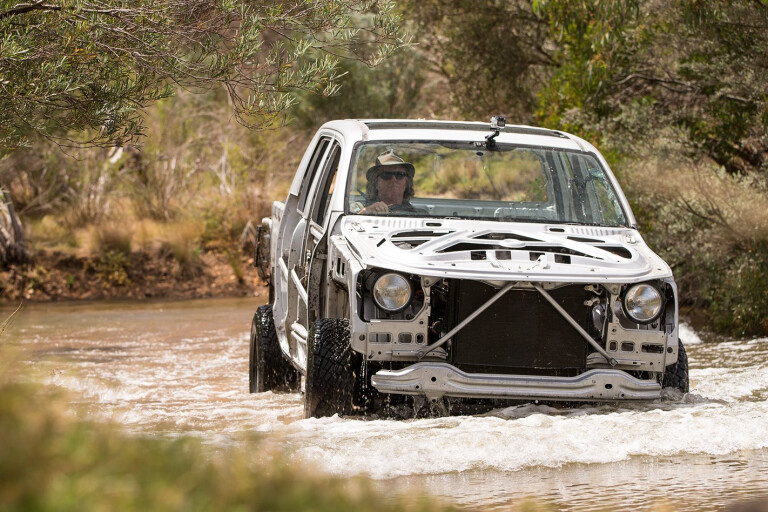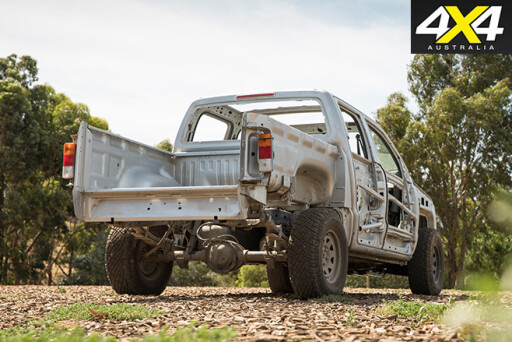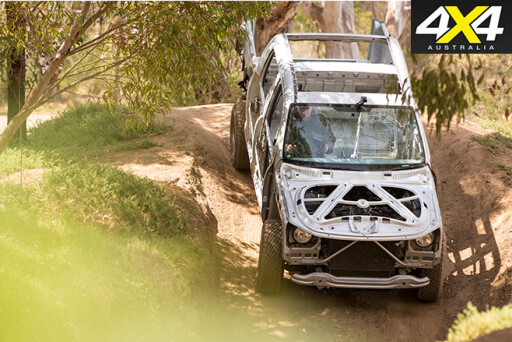
Trying to imagine what things look like without their clothes on is a pastime for many of us and if you’ve ever extended this pastime to a Volkswagen Amarok, the news is good. Your wait is over. Here it is, naked.
What you’re looking at is an Amarok designed to not only reveal its mechanical secrets, but also to be unidentifiable as a VW product.
So it has no badging, no grille, and no exterior panels that might give the game away. And the disguise doesn’t stop there. The headlights and tail-lights are functional but are aftermarket units, as seen on any number of bullbars and boat trailers.
 Inside, anything likely to aid with identification is also gone, including the switchgear, the instruments, with their distinctive VW family appearance, and even the shift pattern from the top of the manual gear lever.
Inside, anything likely to aid with identification is also gone, including the switchgear, the instruments, with their distinctive VW family appearance, and even the shift pattern from the top of the manual gear lever.
VW even removed the seat cushions, preventing onlookers from making an informed guess of the vehicle’s heritage on that basis. In fact, I couldn’t find a single thing that stamped the car as a VW – even the moulded part number on the gearshift boot had been neatly sliced away.
So what’s the story? It’s all part of VW’s latest marketing strategy for the Amarok, which uses social media and television commercials to make potential four-wheel-drive ute buyers think without preconceived ideas about a particular brand.
 It’s also a great way to showcase some of the Amarok’s cleverer elements, since you can now see the wide chassis rails, making for a bigger cabin, and the clever way the rear spring hangers run beside the rails, rather than under them. It’s an Aussie initiative, too. The concept was developed here and the vehicle was built here – it’s not a rip-off of an overseas project.
It’s also a great way to showcase some of the Amarok’s cleverer elements, since you can now see the wide chassis rails, making for a bigger cabin, and the clever way the rear spring hangers run beside the rails, rather than under them. It’s an Aussie initiative, too. The concept was developed here and the vehicle was built here – it’s not a rip-off of an overseas project.
Of course, seeing an Amarok with no exterior sheet metal, no glass apart from a windscreen, no tray, and a stripped-out, sheet-metalled dashboard left us with only one question to ask: can we have a go? Fortunately, VW was eager to let us rip around a closed test track. Too eager, as it turned out – but I’ll get to that in good time.
 The first thing you notice is that it is loud and smelly because there’s nothing to drown out mechanical or road noise and nothing to stop those delicious diesel fumes wafting into the cabin every time you back off the throttle. But thanks to the fact that Skeletor has shed something like 300kg in the process (VW’s best estimate), it takes very little throttle to get it moving pretty smartly.
The first thing you notice is that it is loud and smelly because there’s nothing to drown out mechanical or road noise and nothing to stop those delicious diesel fumes wafting into the cabin every time you back off the throttle. But thanks to the fact that Skeletor has shed something like 300kg in the process (VW’s best estimate), it takes very little throttle to get it moving pretty smartly.
Drive it though a creek, however, and you’ll soon find water oozing up through the many holes in the floor and splooshing in through where the door skins once were. Thinking of tackling a dusty track? You’re going to want to wear breathing apparatus.
 The Naked Ute (as the VW marketing campaign was called) actually started life as a testing and homologation vehicle (known in the trade as a ‘sooty’). It was imported without taxes and duties and can therefore never be sold or registered in this country, so turning it into a tea bag was not the financial wrench it might have been. And once its days on the marketing catwalk are over, it’ll be handed over the VW Australia’s training centre for the apprentice techs to have a crack at.
The Naked Ute (as the VW marketing campaign was called) actually started life as a testing and homologation vehicle (known in the trade as a ‘sooty’). It was imported without taxes and duties and can therefore never be sold or registered in this country, so turning it into a tea bag was not the financial wrench it might have been. And once its days on the marketing catwalk are over, it’ll be handed over the VW Australia’s training centre for the apprentice techs to have a crack at.
Speaking of having a crack, while the Naked Ute lacked any bodywork, all the mechanical bits like the clever turbo set up, bash plates and transfer case (it’s a manual) are still present and accounted for, so it seemed pretty natural to flog the thing around a test track to see if a lack of duds made any difference. Smart money said it wouldn’t. Smart money was wrong.
 On the rocky hills and steep little pinches that made up the test track, the only problem was the amount of dust getting into the cabin. No surprises there. But when it came to trying a water crossing, things didn’t go so well. Now, I’ve crossed plenty of rivers, creeks and floodways in Amaroks, and it’s never been a problem. So, imagine my surprise when this time the VW got almost all the way across a 350mm-deep stream, staggered a little and then carked it.
On the rocky hills and steep little pinches that made up the test track, the only problem was the amount of dust getting into the cabin. No surprises there. But when it came to trying a water crossing, things didn’t go so well. Now, I’ve crossed plenty of rivers, creeks and floodways in Amaroks, and it’s never been a problem. So, imagine my surprise when this time the VW got almost all the way across a 350mm-deep stream, staggered a little and then carked it.
I’ve also heard enough engines being drowned over the years to know exactly what was going on here, so I did what any trained bushman would do: I sloshed across to the bank on foot and went and found a handy Volkswagen techie. Thirty seconds with the screwdriver revealed a soaking wet air filter but, luckily, no real water on the engine side of that filter. So, presumably, we hadn’t hydrauliced the thing. And, sure enough, after a dry filter and a few minutes of idling, the Amarok came good.
 So what went wrong? Pretty simple when you look at it, really. Without the front bumper and a certain amount of sheet metal, the Amarok simply couldn’t set up a bow wave. This allowed the water I was pushing to wash back on to the front of the air box, where it was slurped up into the filter. It was made worse by the lack of the normal grille and plastic bits surrounding the headlight.
So what went wrong? Pretty simple when you look at it, really. Without the front bumper and a certain amount of sheet metal, the Amarok simply couldn’t set up a bow wave. This allowed the water I was pushing to wash back on to the front of the air box, where it was slurped up into the filter. It was made worse by the lack of the normal grille and plastic bits surrounding the headlight.
VW figured this was always going to be a possibility, so it had rigged up a small plastic flap (it looked like one of those plastic trays you get your takeaway beef and black bean sauce in) to try to divert the water a little. It was too little, as it turned out.
It will be interesting to see whether this new marketing campaign will actually get buyers thinking about ditching their current rides for a VW but, if nothing else, it reinforced for me the fact that changing one thing can often have a knock-on effect on something else you would never imagine to be related.

COMMENTS